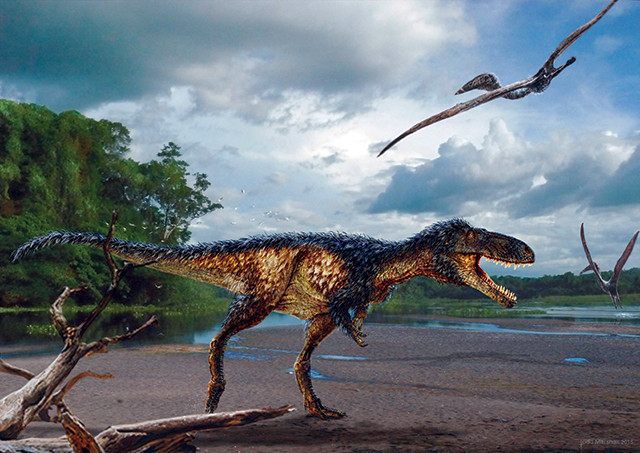
by Mary Caperton Morton Wednesday, June 15, 2016

Fossils of the horse-sized Timurlengia euotica, which lived about 90 million years ago in what is now Uzbekistan, have helped fill a gap in the tyrannosauroid family tree. Credit: Original painting by Todd Marshall.
Tyrannosaurus rex is one of the most recognizable dinosaurs, but the tyrannosauroid family tree is also occupied by many lesser-known cousins — such as Xiongguanlong and Lythronax — along with some large holes. Now, researchers have produced a new phylogenetic family tree including all of the known tyrannosauroid species that highlights the largest remaining gaps and provides clues as to how they might be filled.
“We know more about tyrannosaurs than most other groups of dinosaurs, but there are still some glaring gaps in their fossil record,” says Stephen Brusatte, a paleontologist at the University of Edinburgh in Scotland and a co-author of a new study in Scientific Reports detailing the new tree. “Perhaps most problematically, we don’t know much about what tyrannosaurs were doing during the Early to mid-Cretaceous, right before they switched from [being] marginal human-sized hunters to giant superpredators.”
Ideally, new fossil discoveries will help fill these gaps, but in the meantime, statistics can be used to chart the tyrannosauroid family tree and shed light on how the family evolved toward their eventual superpredator status. To create an updated phylogenetic family tree, Brusatte and his co-author Thomas Carr, a paleontologist at Carthage College in Kenosha, Wis., used two different statistical analyses to chart relationships among known tyrannosauroids based on a set of morphological characteristics, including features of the skull, teeth and limbs. The two statistical methods — parsimony analysis and Bayesian analysis — produced a similar picture.
“The tree produced by this study has more species, with more detailed data on their anatomy, and is generally more inclusive and comprehensive than past efforts,” says Thomas Holtz, a paleontologist at the University of Maryland who was not involved in the new study. “Accurate phylogenies help us see the sequence of assembly of the different physical traits, or how [tyrannosauroids] came to look the way that they did by the Late Cretaceous,” Holtz says. “Phylogenies also tell us about the ecology of each step, about how each animal operated in relation to other predators. What we want to know is how they evolved from Jurassic jackals to the lions of the Cretaceous.”
Among the observations evident from the new family tree is a gap from 120 million to 83 million years ago. “A lot happened in that gap, including a major jump in body size,” Carr says. “There is a whole slew of features that seem to come out of the clear blue sky when we look at the fossil record. But we know things in evolution don’t come out of the clear blue sky. It’s a stepwise process.”
Two newly described tyrannosauroid species have helped fill in that gap: Xiongguanlong, discovered in China in 2009 and thought to have lived sometime between 125 million and 100 million years ago, and Timurlengia, found in Uzbekistan and just announced in March, which lived about 90 million years ago. “Thankfully, the recent discoveries have helped to clarify rather than complicate,” Brusatte says. Timurlengia is the first tyrannosaur that fits into the roughly 20-million-year gap in the middle of the Cretaceous between about 100 million and 83 million years ago. “It fits into the family tree right in the middle, between the oldest, smallest and most primitive species and the last-surviving, apex predatory giants like T. rex. Timurlengia is still small, but it had already evolved the sophisticated brains and senses that would eventually help the huge tyrannosaurs become such great apex predators,” Brusatte says.
Many questions remain about tyrannosauroids, however, especially because the dating of Xiongguanlong has so much uncertainty, and Timurlengia is only known so far from scraps of fossil materials. Major questions that lurk in that gap are how, when and why tyrannosaurs took over the apex theropod position from allosaurs, which dominated the landscape in the Late Jurassic. Another is whether tyrannosaurs were once essentially invasive species, flourishing after they moved into North America from Asia, from where most of the earliest (and smallest) species are known.
The next step in answering these questions, as always in paleontology, will require finding more fossils, Carr says. “Phylogenies don’t fill in the gaps, they show us where the gaps are and they give us a way to narrow down the most important remaining questions,” he says. “Ultimately, they help us be honest with ourselves about what we really know and how much we still have to learn.”
© 2008-2021. All rights reserved. Any copying, redistribution or retransmission of any of the contents of this service without the expressed written permission of the American Geosciences Institute is expressly prohibited. Click here for all copyright requests.